
Airbnb is a modern-day success story that has transformed the travel and hospitality industry.
With just a few clicks, anyone can rent out their free space or book a night in a stranger's apartment, treehouse, or even a castle.
In March 2017, Airbnb raised over $3 billion in its last fundraising round, which valued the company at over $31 billion. This staggering achievement is a testament to the effectiveness of their business model.
Airbnb's visionary idea was originally written on a single piece of paper in 2014, and it outlined the company's goals, objectives, features, key dates, and important milestones. This document was half-jokingly referred to as "the infamous paper to take over the world" by Chip Conley, who was the head of global hospitality at the time.
The document condensed months of strategic thinking, business planning, and research into an easily digestible format. This allowed the entire company to stay focused on becoming a billion-dollar unicorn, and it ultimately led to the success of Airbnb as we know it today.
That, my friends, is the incredible power of a business roadmap.
What is a business roadmap?
A business roadmap is a long-term strategic planning document showing your company's goals and the steps required to get there.
Unlike lengthy business plans, it does not show the individual items and activities required in fine detail.
Instead, it focuses on the big picture, clearly showing your company's major, business goals and objectives, and the high-level strategies it will use to achieve these — this helps keep stakeholders and team members aligned and on track to succeed.
But most importantly, business roadmaps are not set in stone. The activities and priorities outlined in a business roadmap are open to debate and can be reshuffled if needed to better reflect the current environment.
The most common use case for a business roadmap is to show how the business plans to grow. Still, they can be used for other strategic projects, such as change management, enterprise architecture projects, or even by individual departments.
The 4 main types of business roadmaps
Generally speaking, there are four main types of business roadmaps. They are:
Department roadmaps. These are roadmaps that define and explain how a particular department can move forward to address its goals. Defining a department roadmap is one of the best ways to ensure that the entire team is on the same page and working towards the same objectives.
Business development roadmaps. On the other hand, business development roadmaps encompass the bigger picture of your business. Rather than looking at various departments' goals, this looks at the larger goal that all departments are working together to reach, and how they'll reach that goal.
Product roadmaps. Product roadmaps are useful for identifying the goals of a particular product and outlining the phases of development that will need to happen to get there. A product roadmap should encompass the entire lifecycle of the product, not just pre-deployment.
Project roadmaps. Similar to a product roadmap, a project roadmap is a roadmap that generally involves a small group of people, such as one team. The project can be a product to be released, internal app development, redesigning a space, and so on.
Business roadmap examples to inspire and guide you
Let's look at some business roadmap examples. Below are some important roadmap examples, some of them are more specialized than others, these can hopefully inspire you to start moving your business forward in a structured, organized way.
1. Business capability roadmap
Now that you have an idea of the main types of business roadmaps, let's look at and define the qualities of more specialized roadmaps, starting with a business capability roadmap. This roadmap is used to outline the large-scale capabilities a business would like to have.
For instance, if your business is looking to target a specific demographic, break into a particular market, or offer a new service, this would fall under a business capability roadmap.
What can your business do to develop the capability to produce a product or supply a service, and how will it accomplish these tasks?
Example of a business capability roadmap
It's easy to find tools and examples online that will help you create your own business capability roadmap. These roadmaps take on different forms and routes, though most focus on dividing tasks between departments and teams.
From there, arrows or some other directional icon illustrate which tasks need to be completed first for the next set of tasks to begin. This can look like a Kanban board or a traditional brain-mapping tool.
2. Business transformation roadmap
Business transformation roadmaps analyze the current state of your business, set goals for how you want to change your business in significant ways, and then outline how you will get there.
The most common reason for using a business transformation roadmap in today's world is digital transformation. That's the process of transitioning traditional workflows and strategies into digital workflows and strategies.
Example of a business transformation roadmap
In a business transformation roadmap, the focus will be on transforming each department individually rather than looking at how the changes in each department interact with one another. There will be some overlap, but for the most part, each department will have a unique roadmap.
That roadmap will involve how various tools and processes can be replaced or replicated digitally. Then, it'll assign that process to multiple department heads and teams. It should also include the allocation of resources required for the transition.
3. Strategic roadmap
A strategic roadmap outlines a vision for your business. It's a mission you want to complete, a value you wish to embody, or a product you want to deploy. Whatever it is, the purpose of a strategic roadmap is to help you get there.
4. Content calendar roadmap
A content calendar roadmap maps out the content your business will be creating and publishing in a given timeframe. Generally, a content calendar roadmap is reused repeatedly as you build up your content strategy.
5. IT architecture roadmap
The last roadmap example we'll touch on is an IT architecture roadmap. This type of roadmap helps your business implement the right types of technology and infrastructure. It's usually very detailed and aims to keep your business modernized and secure.
Who can use a business roadmap?
Whether you are an entrepreneur, a business owner, or a marketing manager, everyone can use a business roadmap to make communicating complicated business strategy almost effortless.
You can even use a business roadmap to plan your own career path — what do you want to achieve, by when, and why?
By identifying potential opportunities to grow and develop, as well as the partners and resources you'll need to make that happen, you'll be in the driver's seat, whichever industry you work in.
Entrepreneurs
As an entrepreneur, a business roadmap is critical to organizational growth.

You've probably got a million ideas and just as many responsibilities, so regularly reviewing your twenty-page business plan simply isn't possible (or advisable!).
Instead, you should create a business roadmap.
At a glance, you can see how your current activities relate to your business's long-term strategic goals and objectives and instantly make changes if required.
As a roadmap is so easy to review, you can share this with new team members to quickly bring them up to speed. You could also use it to get buy-in from investors, quickly illustrating your future growth potential and what their investment would enable you to achieve.
Business owners
As a business leader, you likely have a crystal clear idea of where you want to take the organization in the future. You wake up every morning with a serious mission statement in mind — after all, you built this company with purpose, and that purpose acts as your true north in everything you do.
You know where you're going… but does anyone else?

For small business owners, a business roadmap and financial capital is essential.
It helps you structure your business vision, reign in your ambition, and see the essential steps required to move forward. You'll also be able to predict risks along the way and what resources you'll need to bring your dream to life. For example, you may have ambitious development tasks up ahead — the remit for which lies beyond your personal technical capabilities. Here, finding an appropriate partner will be necessary to avoid any costly mistakes.
For more established companies and smaller businesses, a business roadmap will help you explore new directions for business operations, identify inefficiencies, and fine-tune your focus as the market evolves.
If you are looking to sell your company, you might not be focused on long-term strategy. However, an effective business roadmap helps and will increase the value of your business.
In this instance, creating a strategic business roadmap will help stabilize and motivate your management team. With a clear direction, your key personnel can continue to do their best work, even if you leave the business.
It will also show real potential for growth, demonstrating to buyers the potential future value of your business.
Business managers
Managers and sales teams are uniquely placed to recognize business needs and opportunities.

You see what happens every day, on the ‘front line,' but you've also got access to the C-Suite to ask for further funding.
Perhaps you've got big ideas on how to achieve your goals and need to convince senior management or executives in your organization. Perhaps you need more team members, resources, or just support for your strategy.
So how do you get it?
Don't waste your time writing a lengthy document or a complicated presentation
Instead, use a business roadmap.
By boiling down your big idea into key steps, you'll keep your audience engaged and focused on the benefits of your strategy rather than the difficult implementation details.
Business roadmap vs. business plan — what’s the difference?
Historically, business plans have been an essential document for any business.
As little as a decade ago, if you approached someone with a business concept without a fully bound, multi-page business plan, you'd have been called naive and underprepared.
However, attitudes are changing. And the entire business world has become more fast-moving and agile.
Stories of businesses raising millions in investment from just a pitch deck (Uber) or a 1-page document (Airbnb) are now commonplace, and lengthy business plans feel like a thing of the past.
So, let's put a business plan and a business development roadmap head-to-head...
What is a business plan?
A business plan is a document that explains the commercial potential of a business.
There are no rules for what it should include, but it generally takes an essay format with structured sections that explain what your company is going to do, how it will achieve its goals, what the key risks are, and what the opportunity is. It often includes projected cash flow and other financial predictions.
Sure, they might be traditional, but a comprehensive business plan does have its advantages:
It demonstrates to investors, lenders, and other interested parties that you've done the research necessary to build the business correctly.
It shows the financial viability of your company in detail.
It helps get everyone involved on the same page and aligned on the direction of the company.
It might be required to get business loans or government grants. Some traditional investors expect to see a lengthy business plan.
There is hard evidence of the effectiveness of good business plans, too — a study by Professor Andrew Burke from the Cranfield School of Management proved that companies that write plans and use them grow 30% faster than businesses that fail to plan.
The problem with business plans...
The thing is, a comprehensive business plan takes time to create.

Choosing the right words, creating countless tables, and doing comprehensive research might reveal valuable insights and tell a compelling story, but it also drags you away from building your product, talking to customers, or getting real market feedback.
In 2018, the Harvard Business Review wrote:
“The real key to succeeding in business is being flexible and responsive to opportunities. Entrepreneurs often have to pivot their business once it becomes clear that their original customer is not the right customer or when it turns out that their product or service fits better in an alternate market. Because of these realities, business plans are written at the start end up nothing more than a fable”.
Enter: the business roadmap and all its benefits!
This is where a business roadmap truly excels. By focusing on high-level steps, the benefits are:
It can be reviewed quickly and constantly, enabling everyone to check if they are on track.
When the product, market, or opportunity shifts, the roadmap can be modified quickly.
It keeps the business focused on the big picture, spotting potential roadblocks and obstacles earlier.
So, which is best?
A business plan is still a critical document for many businesses today, particularly those who need one to secure funding, financing, or convince traditional investors.
Yet, modern businesses benefit from increased agility, making a business roadmap a leaner, faster, and more responsive document.
In our view, there's one clear winner: the business roadmap. However, most of the time, a business roadmap and a business plan work hand-in-hand.
How to define goals for a business roadmap
By now, you should have an understanding of what a business roadmap is and how it can be applied in your business to map your strategic direction.
Probably you're pretty eager to get started building your roadmap now
But, it's important to realize that the strategic thought that takes place before you create your roadmap is just as valuable as the act of creating the strategic roadmap itself.
Start with foundations by setting effective goals.
Then, build your business roadmap shows how to achieve these goals.
1. Understanding long-term goals
What specific objectives do you want to achieve in the next 3 to 5 years?
These long-term strategic goals that will help shape your business roadmap — if an activity doesn't play a role in helping you reach a long-term goal, then it doesn't deserve a place in the business intelligence roadmap today.

Long-term goals can be associated with:
Revenue: The simplest to explain but the hardest to achieve, e.g., increasing profits or revenue by a certain percentage within a defined time.
Growth: Expand the company through new employees, resources, or other key measures.
Service and reputation: Improve the quality of your services, leading to increased customer satisfaction or customer retention.
Social: Increasingly, businesses are setting long-term goals to give back to society or the environment.
2. Setting short-term goals
The context set by long-term goals helps you identify what you need to do in the near future to progress along your business objective strategic journey. Short-term goals are ideal milestones or destinations for your business objectives strategic roadmap now.

Remember, the best short term goals are SMART:
Specific. They should be targeted and highly detailed, so they can be easily understood.
Measurable. Set a metric that can be continually reviewed. This will prove progress is being made.
Action-oriented. Specify what actions need to be taken and when.
Realistic. Goals should be challenging but achievable. Make your goals realistic by reflecting on your past performance.
Time-specific. Look ahead and set a hard deadline to keep things on track.
3. Speak with stakeholders
Once you've got a solid understanding of both your long and short-term goals, it's essential to get your team or employees motivated to achieve them.

Involve them in the process of creating your goals and listen intently to their feedback. After all, if they feel they helped shape where the company's vision is headed, they will be more motivated to get there.
4. Identify key steps on your roadmap
Now for the exciting part — the first steps of building your startup roadmap are:
Look at your goals and consider what major steps will be required to achieve them.
Annotate each of those steps with a brief high-level description.
Place these steps into order and consider whether you will have the resources required (such as people and time) to complete them. Make sure you can defend why the steps should be completed in this order.
Critique your roadmap — is this realistic? If conditions change, can your roadmap adapt?

How to prioritize using a business roadmap template
No team has unlimited resources.
So to help you decide which projects or initiatives deserve a place in your business roadmap, you need to learn how to prioritize. This will make sure you get the most impact on your goals with the fewest resources possible.
There are many different approaches to prioritizing a roadmap, but the most quantitative and scientific way is to use a "prioritization matrix" or "weighted scoring model". This is a proven and field-tested framework used by companies like Nike, Shell, and The Washington Post. It will identify key risks and help your roadmap be as focused and successful as possible.
We built ready-to-use prioritization frameworks within all of our templates, so you don't need to invent your own. But, if you prefer to do it manually, here is a step-by-step business roadmap prioritization guide.
1. Determine choices
Write down all the possible things you could add to your roadmap right now. For example, this could be a new sales initiative, a new marketing campaign, or a recruitment cycle.
2. Pick and rate criteria
Next, you need to figure out how you'll decide which item is more important than the others. These will be unique to your organization but could be current business goals like revenue increase, cost to implement, or strategic fit.
You can optionally assign these items a weight, showing how important each of the criteria is to your business.
For example, your primary goal for the year might be to increase revenue, so you might double the weight of this criteria.
Place these criteria into a table as below:

On a simple 1-5 scale, rate each of the rows in the columns. 5 is most desirable, and 1 is least desirable — for example, for 5 could mean high revenue potential and lowest cost.
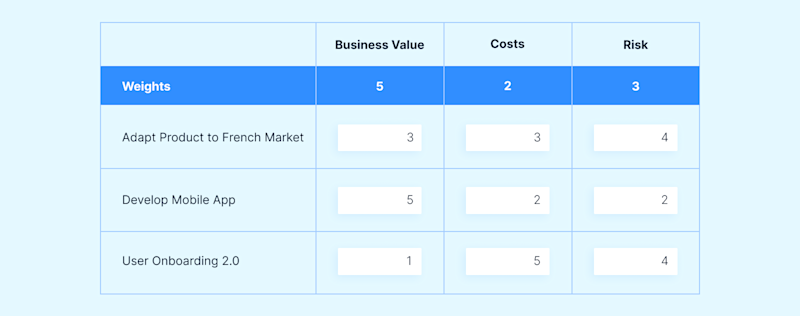
3. Calculate
Multiply your scores by their weight. The highest scoring total rows are your priorities.
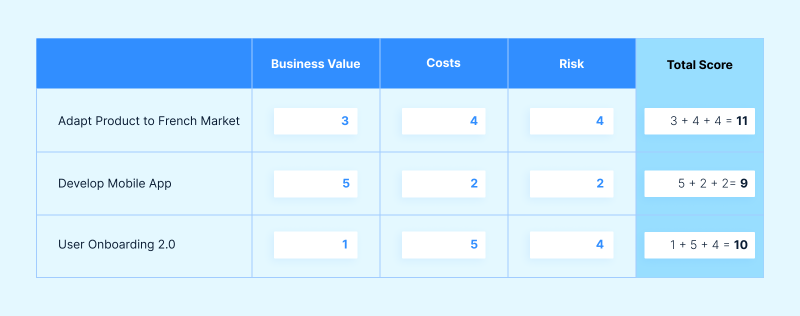
Multiply your scores by their weight. The highest scoring total rows are your priorities.
Now you understand how to use this matrix, you can plan and explain your product prioritization decisions to stakeholders.
To save time, try using the airfocus built-in scoring feature and prioritization tool, which does all the hard calculations work for you.
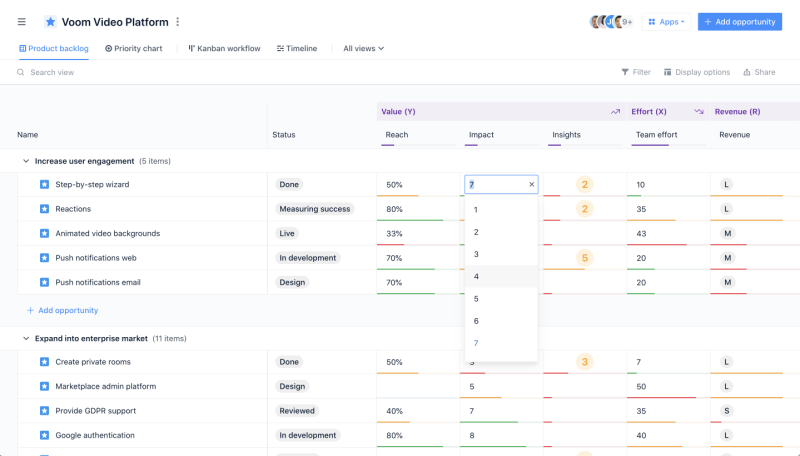
A quick rundown of business roadmap templates...
You don't need to start from scratch with your business roadmap.
These templates all allow for unique roadmapping requirements — including a built-in prioritization feature, which can flex to your unique criteria.
For marketing teams, calculate the impact of your work with this marketing planning and prioritization template. Simply change the value criteria from brand awareness to whatever KPI you are tracking.
Business owner, strategist, consultant, or executive? Get everyone on the same page instantly with our business project roadmap template. Justify your decisions and spend with the built-in prioritization matrix
Startup founder? Build a billion-dollar empire by bringing order to chaos with this startup roadmap template. It'll tell you in seconds what you should be working on next.
How to make a business roadmap with airfocus:
Creating a business roadmap is simple with airfocus.
Start by selecting our business roadmap template. We offer pre-built templates for various situations that are fully adjustable and built on proven decision-making and roadmapping methods. Plus, our templates are fully customizable — giving you the best of both worlds.
Add your projects, features, and initiatives manually or import them from your existing tools.
2. airfocus integrates Jira, Trello, Asana, or CSV as well as 1000+ other tools via Zapier.
3. Once you've added your items, you can map your priorities on a chart to better understand the most important projects.
4. Next, organize your items into a beautiful roadmap with a simple drag-and-drop on prioritization chart
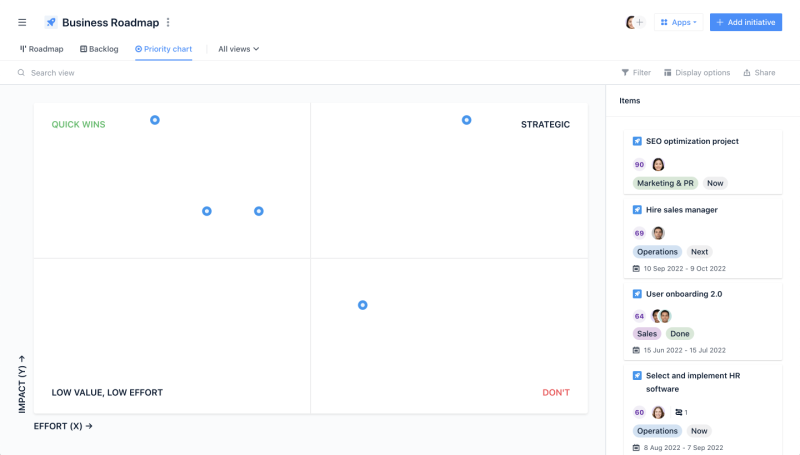
b. Timeline view
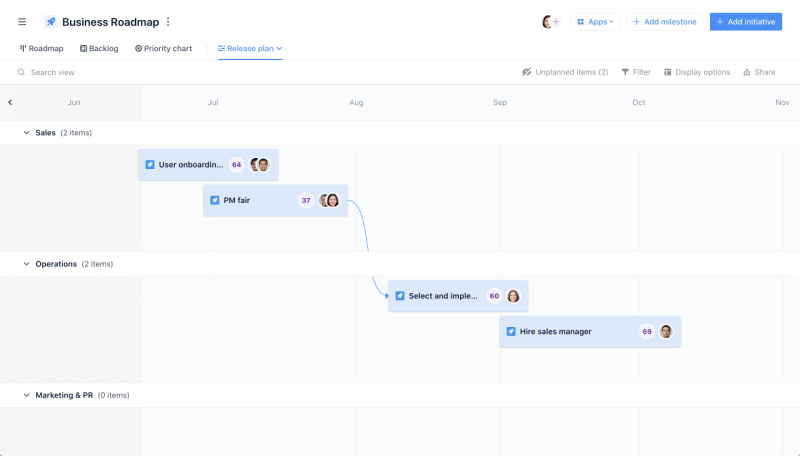
c. Table view
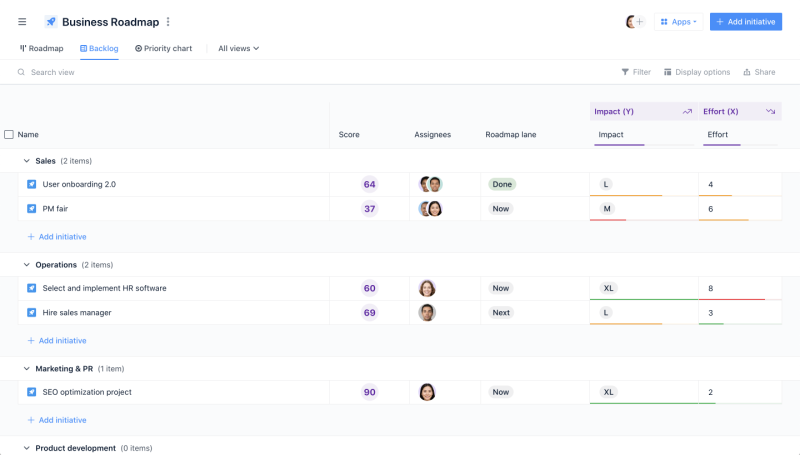
5. In the end, use a share link to communicate your strategy within minutes, ensuring that everyone is on the same page. As your priorities evolve, the shared version will also be updated, ensuring that everyone remains informed.
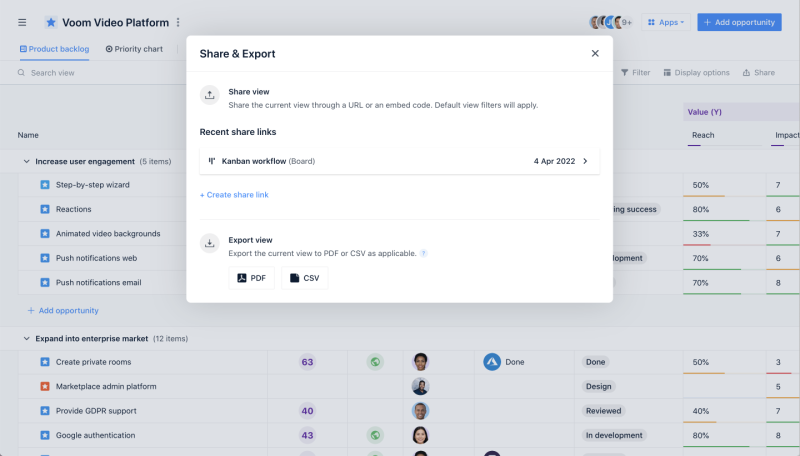
6. Don't forget to regularly revisit your roadmap to ensure you are on track!
Defining KPIs for your business roadmap
KPIs, or Key Performance Indicators, are metrics your business can measure to track its performance in certain areas. Technically, any aspect of your business's performance that you can measure is a "Performance Indicator."
However, what makes a "PI" a "KPI" is the metric's impact. For example, your monthly revenue might be valuable to a product supplier but absolutely essential for a subscription-based service.
In other words, a KPI is a crucial measurement of your business's performance, indicating an important trend.
How to define KPIs for your business roadmap
For businesses in the modern age, picking and accurately measuring the correct KPIs is a crucial step in creating a successful business roadmap. Here are a few important tips for defining the KPIs that make up your business's roadmap.
Identify your essential metrics
First, you should identify your essential metrics. As mentioned, these are the metrics that represent the biggest impact on your business. You can also think of these as the metrics that indicate trends (positive and negative) for your business.
For example, a subscription-based business might want to look at monthly users and revenue, while a fast-food restaurant might consider customer retention and order delivery times.
If you're having a hard time deciding which KPIs are essential for your business, you can easily find recommended KPIs online for your business model. This is usually a good place to start.
Examine your roadmap
Next, you'll want to examine your business roadmap. How do your outlined steps and goals correlate with your chosen KPIs? Do they directly relate? Are there indirect relationships?
Connecting these dots can help you determine two important things:
Is your business roadmap truly aligned with your business's strengths and weaknesses? Is it a good outline?
Have you chosen KPIs relevant to your business's goals and strategies?
Use your KPIs to make decisions
With those initial steps completed, you can start incorporating your KPIs into your overall strategy. That will primarily mean using your KPIs to make important decisions.
Thinking about investing in a new service? Launching a new product? Making an acquisition? Consulting your KPIs and your business roadmap can help you quickly say "Yes" or "No" to these types of opportunities.
They paint a picture of where your business currently is so you can see where you stand without wasting too much time.
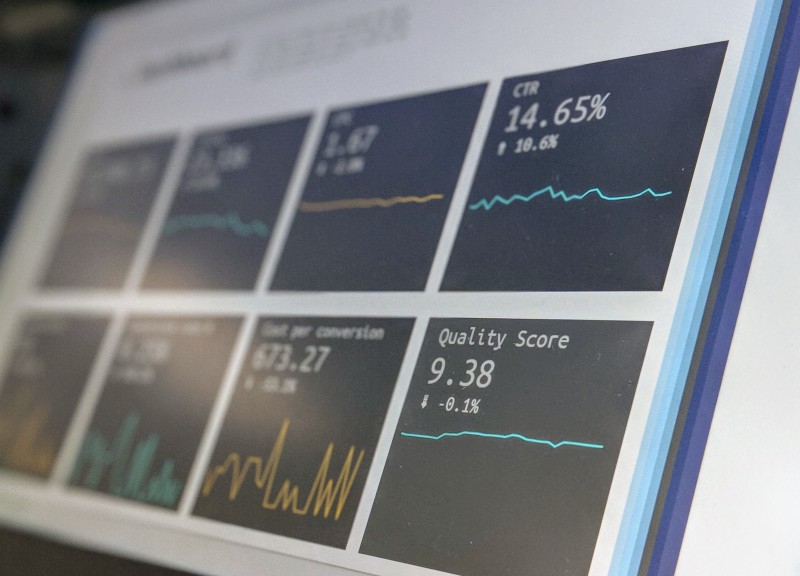
Incorporating customer feedback into your business roadmap
Of course, KPIs aren't the only factor you should consider when creating a business roadmap. Another important consideration is customer feedback because it can also help point you in the right direction.
How to incorporate customer feedback into your business roadmap
Collect your feedback in one place
An important factor in collecting customer feedback is ensuring it's all kept in one place. If you don't have a plan for collecting customer feedback, then you aren't really collecting it — you're just haphazardly hoarding it.
Using a tool that connects feedback you receive in-app, through customer support channels, and directly on your website will help you stay organized and quickly analyze what your feedback is telling you. It tells the story of your feedback rather than forcing you to dig through it yourself.
Use feedback to inform current and future projects
Feedback can also be helpful as a tool for informing your current and future projects. For example, you may be working on a feature only a few of your users have seen. If you're mainly getting negative responses, it might be time to rethink this feature.
On the other hand, if you're getting requests for a new kind of feature, you may want to start moving in that direction.
Assess your products and processes
Another way to use customer feedback is to assess whether your products and processes meet your users' needs. How are customers receiving your products? Are your processes living up to customer expectations?
Feedback can be a light in the dark, giving you a solid idea of how to move in a way that will make customers happy.
The role of technology in business roadmaps
Of course, you can also lean on technology when building and refining your business roadmaps. It can help in various ways, some of which we'll cover below.
How to use technology for your business roadmap
Use roadmapping software
One of the first and best ways to use technology for your business roadmap is by leaning on roadmapping software. These tools can streamline your process for creating, editing, and sharing your business roadmap.
airfocus is a great tool for this purpose. Our modular solution has been refined to make your job as simple as possible.
Use roadmap templates
Business roadmap templates, while fairly "low-tech," can also speed up your process. They do most of the heavy lifting for you, so you just have to focus on filling them. They're a great resource if you're not sure where to start.
Use feedback management tools
When it comes to collecting, organizing, and implementing feedback, feedback management tools are your best friend. They help structure and bring together all of your customer feedback in a single location, simplifying your job and painting an overarching picture that is easy to understand.
Use technology to engage with your community
Of course, you don't just want to collect feedback from your community. You want to be interactive and engaging. Technological tools like airfocus Portal, can also help you out here, giving you a tool for directly interacting with customers and effectively closing the loop.
Use AI to make things simple and quick
AI is already making significant enough strides to help you start refining and creating your business roadmaps. airfocus has AI Assist, a powerful AI tool to help you create high-quality, high-impact business roadmaps.
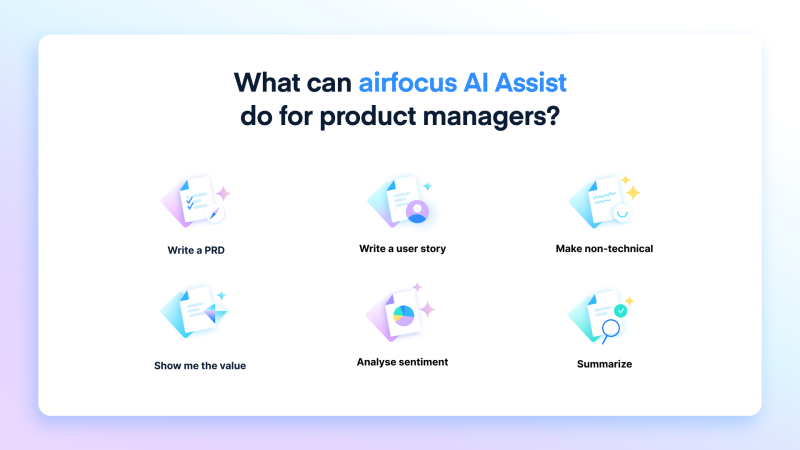
Finally, a business roadmap checklist — are you ready?
Don't worry if your head is spinning a little with all this new information.
Once you're in the swing of things, creating a business roadmap will become second nature.
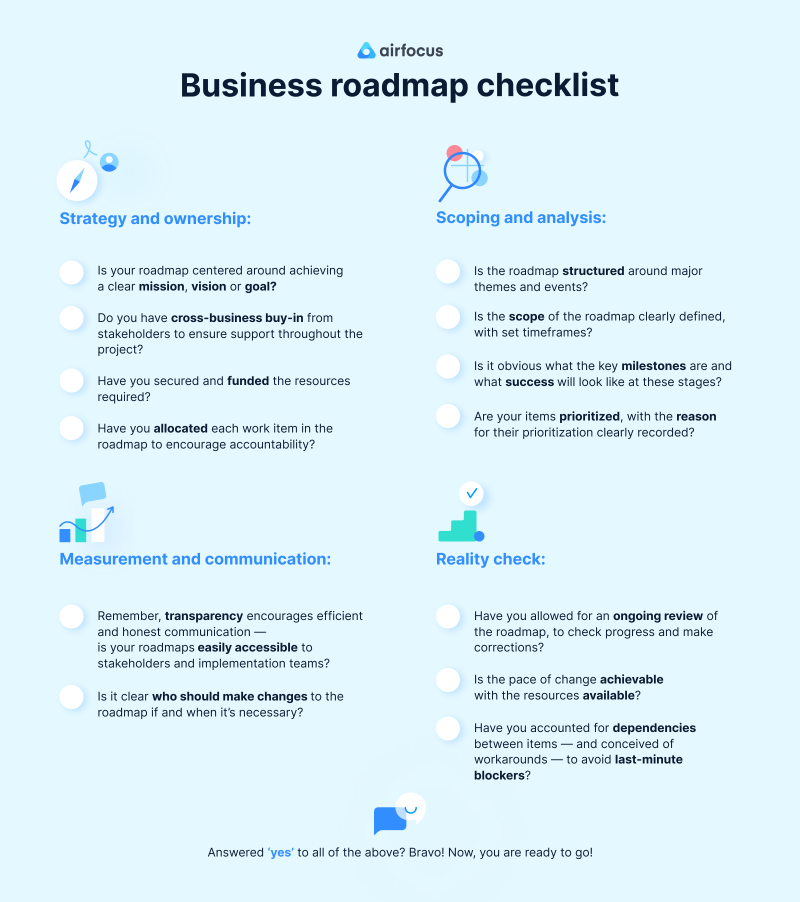
For now, though, simply follow the checklist to make sure you've crossed all the Ts and dotted all the Is...
Strategy and ownership:
Is your roadmap centered around achieving a clear mission, vision or goal?
Do you have cross-business buy-in from stakeholders to ensure support throughout the project?
Have you secured and funded the resources required?
Have you allocated each work item in the roadmap to encourage accountability?
Scoping and analysis:
Is the roadmap structured around major themes and events?
Is the scope of the roadmap clearly defined, with set timeframes?
Is it obvious what the key milestones are and what success will look like at these stages?
Are your items prioritized, with the reason for their prioritization clearly recorded?
Measurement and communication:
Remember, transparency encourages efficient and honest communication — is your roadmaps easily accessible to stakeholders and implementation teams?
Is it clear who should make changes to the roadmap if and when it's necessary?
Reality check:
Have you allowed for an ongoing review of the roadmap, to check progress and make corrections?
Is the pace of change achievable with the resources available?
Have you accounted for dependencies between items — and conceived of workarounds — to avoid last-minute blockers?
Answered ‘yes' to all of the above?!
That's it!
Now, you are ready to go!
Don't forget - a compelling business roadmap isn't designed to replace the business plan entirely. Instead, a compelling business roadmap will help you stay on track and quickly reshuffle your priorities — visually communicating changes to all stakeholders whilst supporting strategic decisions with valid data.
If you're totally new to roadmapping, there are tonnes more to learn over on our blog.
airfocus was designed to help managers get the right stuff done, and to make things easier, you can use one of our business roadmap templates to get started. There are dozens to choose from on our website, so go take a look.

Malte Scholz

Read also

Build great roadmaps

Experience the new way of doing product management







